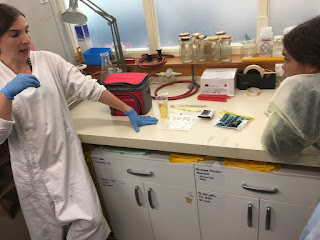Monitoring water quality in Rotokawau / Virginia lake, Whanganui, New Zealand
 |
| Rotokawau / Virginia lake, May 2018 https://www.nzherald.co.nz |
The health of Rotokawau / Virginia lake has been in the local news quite a lot over the last few years because of the frequency with which unsightly algal blooms plague the lake. Our interest as a school Science department developed out of a place-based study we were doing at the time, researching and writing about the impact of farming on the environment. It did not take long for students who were learning about eutrophication and the effects of fertilisers and farm run off on the quality of water in our waterways, to ask the question why was Rotokawau / Virginia lake affected in the same way? After some thought and considerable investment, we decided we would undertake to monitor the lake over the course of one year to see what we could find out.
The Māori name for Virginia lake is Rotokawau and it was given this name after the black shag birds that use to inhabit the lake area in large numbers. Pākehā called it Virginia lake because it was perceived to be similar in appearance to Virginia Water in Surrey, England. Since March 2016 the dual heritage of the lake has been recognised and it is now officially known in the Whanganui district as Rotokawau / Virginia lake.
Rotokawau / Virginia lake is an example of what is called a dune lake. These lakes are found along the west coast of the North Island of New Zealand and are formed when a stream is dammed by wind blown sand or when an existing dune depression is filled with clay and silt, or sits on hard pan, which then reduces sub-surface water drainage to form a lake. The lack of a direct inflow of water into Rotokawau / Virginia lake makes the latter origins more likely. Another, less than peaceful, beginning for Rotokawau / Virginia lake comes from a story that was shared with us from kōrero tuko iho. Local people asked a tohunga to rid them of a dangerous but well connected individual. Uppermost in the people's minds was the need to avoid shedding blood on the land and creating a tapu. It is said therefore, that Rotokawau / Virginia lake was created for the sole purpose of drowning this unfortunate individual.
 |
| https://collections.tepapa.govt.nz/object/706869 |
Rotomokoia/ Westmere lake is another nearby example of a dune lake and both lakes have been important features of the city's water supply in the past. After Virginia lake was purchased for the town in 1884, plans were put in place to make the lake look more attractive. Scrub and ferns were removed and the area extensively replanted. The reserve opened to the public in 1914.
Land was not developed for housing on the eastern section of the lake until the 1950's and the Otamatea sub-division to the north west was developed in 2000-10. In recent times stormwater run-off from the new sub-division has been blamed as the source of the nutrients that cause algal blooms. A 2004 NIWA report said this was not the case and that the major source of nutrient enrichment in the lake was through ground water seepage. Wanganui Chronicle The area surrounding the lake has been linked to the agricultural land to the north of the city up until most recent times.



Comments
Post a Comment